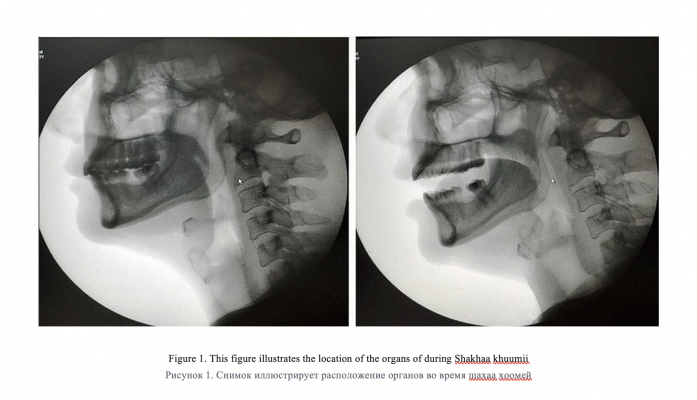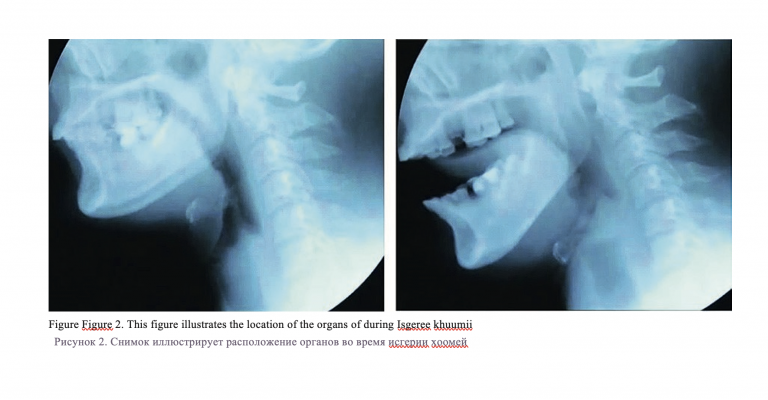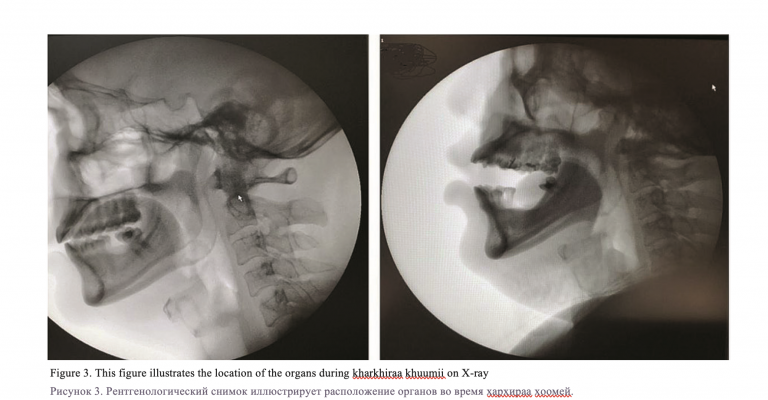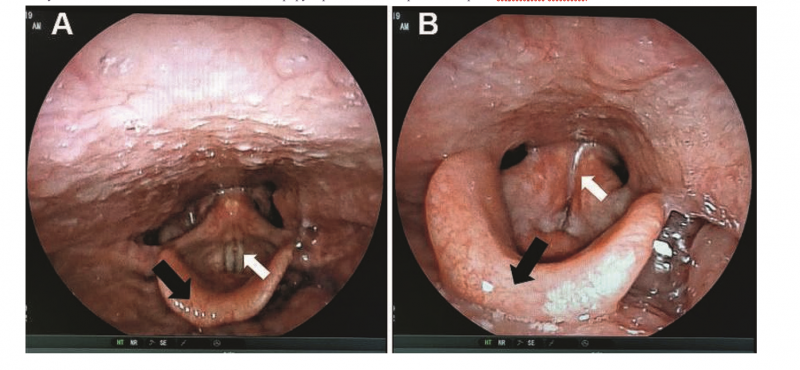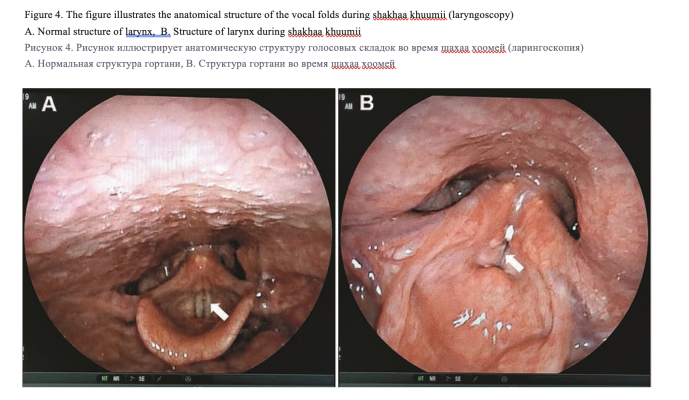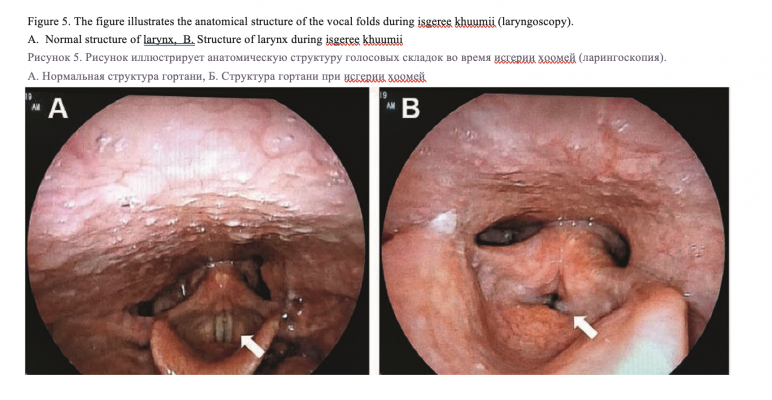Для цитирования:
Рентсендорж Ц., Энебиш С., Юрамт Б., Ууртуя Ш., Ганчимег П., Бямбасурен Л., Доржусен Ц., Эрдембилег Ц., Амгаланбаатар Д., Дагданбазар Б., Ниамдорж Д. Исследование структуры и функций органов, участвующих в формировании звука монгольского Хоомей. Голова и шея. Российский журнал = Head and neck. Russian Journal. 2020;8(3):8–15
Авторы несут ответственность за оригинальность представленных данных и возможность публикации иллюстративного материала – таблиц, рисунков, фотографий пациентов.
For citation:
Rentsendorj Ts, Enebish S, Juramt B, Uurtuya Sh, Ganchimeg P, Byambasuren L, Dorjsuren Ts, Erdembileg Ts, Amgalanbaatar D, Dagdanbazar B, Nyamdorj D. A study on structure and functions of organs involved in the formation of mongolian khuumii sound. Head and neck. Russian Journal. 2020;8(3):8–15
The authors are responsible for the originality of the data presented and the possibility of publishing illustrative material – tables, figures, photographs of patients.
Doi: 10.25792/HN.2020.8.3.8–15
Хоомей (горловое пение) – уникальная форма искусства, созданная кочевым населением Центральной Азии. Исполнители хоомей воспроизводят два или более звука либо мелодии одновременно с помощью органов речи. Целью исследования являлось выявление анатомических структур, участвующих в формировании хоомей, особенностей и закономерностей их функций, а также сравнение типов хоомей в исполнении монголов. В нерандомизированное поперечное исследование были включены 60 участников в возрасте 18-60 лет (54 мужчины и 6 женщин). Статистический анализ проводился при помощи программного обеспечения SPSS 23 с использованием анкетирования, рентгенографии, эндоскопии, метода исследования звуков и общих анализов крови.
90,7% исполнителей были мужского пола и 9,3% – женского. Средний рост участников составил 172,91 ±0,93 см (среднее арифметическое и ошибка среднего), средняя масса тела – 77,53±2,46 кг, индекс массы тела – 25,93±5,31. Частота сердечных сокращений в минуту до исполнения составляла 92,19±20,71, после исполнения – 133,19±19,09 и 85,81-98,56 с 95% доверительным интервалом. С точки зрения этнической принадлежности (этнографически) больше всего участников принадлежали к группе халха (72,1%), затем следовали баяды, буряты, даркхады, торгууды и ойраты (2,3%) соответственно. 60,5% участников были профессиональными певцами хоомей, окончившими соответствующие университеты и колледжи. Процесс Хоомей был записан рентгенологически; движение истинных и ложных голосовых связок, объем глотки, движения надгортанника и аритеноидного хряща и слизистой оболочки были оценены эндоскопически. Хоомей увеличивает нагрузку на сердечно-сосудистую систему на 70–80%. Частота звука при этом в 2–4 раза, а громкость в 0,5–1 раза выше, чем у обычной речи. У 95,3% певцов не отмечалось боли в горле, у 88,4% не было одышки, у 74,1% не было охриплости. При формировании звука хоомей грудная полость, диафрагма и легкие регулируют интенсивность потока воздуха, достигающего голосовых складок, оказывают давление на дыхательные пути и вызывают вибрацию звуковых волн через воздушные потоки в гортани и голосовых складках. Ротовая и носовая полости, а также глотка отвечают за резонанс звука. Уместно разделить хоомей на два основных стиля в соответствии со структурными и функциональными изменениями в вовлеченных органах; шахаа и хархираа. «Хоомей», «человеческая музыка», изобретенная жителями Алтай-Хангайского бассейна в древние времена путем имитации голосом звуков природы, распространилась по всему миру из Монголии.
Ключевые слова: горловое пение; истинная голосовая связка; ложная голосовая складка; источник голоса; режим вибрации; фониатрия
Конфликт интересов. Авторы заявляют об отсутствии конфликта интересов.
Финансирование. Работа выполнена без спонсорской поддержки
Khuumii (throat singing) is a unique form of art derived from the nomadic population of Central Asia, producing two or more “simultaneous” sounds and melodies through the organ of speech. The aim of the study is to identify the anatomical structures involved in the formation of khuumii and the features and patterns of their functions and compare each type of khuumii as performed by Mongolian people. A total of 60 participants aged 18-60 years (54 men and 6 women) were selected by non-random sampling method using cross-sectional study. Statistical analysis was performed using SPSS 23 software using questionnaires, X-ray, endoscopy, sound research method, and general blood tests.
90.7% of the khuumii singers were male and 9.3% were female. The average height of the participants was 172.91±0.93 cm (arithmetic mean and mean error), average body weight was 77.53±2.46 kg, and body mass index was 25.93±5.31 respectively. Heart rate was 92.19±20.71 per minute prior to khuumii while 133.19±19.09 after performing khuumii and 85.81-98.56 at 95% confidence interval. In terms of ethnicity (ethnographically), the Khalkh were the largest ethnic group (72.1%), followed by Bayad, Buryatia, Darkhad, Torguud, and Oirat (2.3%), respectively. 60.5% of the participants were professional khuumii singers who graduated from relevant universities and colleges.
The process of Khuumii was recorded by X-ray examination, and laryngeal endoscopy evaluated the movement of true and false vocal chords, glottal volume, movements of epiglottis and arytenoid cartilage, and mucosa. Khuumii increases the workload of the cardiovascular system by 70-80%. Furthermore, the sound frequency is 2-4 times higher than that of normal speech, and sound volume is 0.5-1 times higher. 95.3% of throat singers did not have a sore throat, 88.4% did not experience heavy breathing, and 74.1% had no hoarseness. During the formation of khuumii sound, thoracic cavity, diaphragm, and lungs regulate the intensity of the air reaching the vocal folds, exert pressure on the airways and vibrate the sound waves through air flows passing through the larynx and vocal folds. Mouth-nose cavity as well as pharynx are responsible for resonating the sound. It is appropriate to divide khuumii into two main styles according to structural and functional changes in the organs involved; shakhaa and kharkhiraa. Khuumii, the “Human music” originating from the people of Altai Khangai basin by imitating the sounds of nature with their own voice in ancient times, spread all over the world from Mongolia. Keywords: throat singing; true vocal fold; false vocal fold; voice source; vibration mode; phoniatry
Conflicts of interest. The authors have no conflicts of interest to declare.
Funding. There was no funding for this study.
Introduction
Khuumii is a unique form of art originated from the nomadic people of Central Asia, producing two or more “simultaneous” sounds through the organs of speech [1]. The origin and development of khuumii in Mongolia was confirmed by UNESCO and registered in the list of intangible cultural heritage of mankind in 2010 [2]. As stated in the Decree of the President of Mongolia dated January 5, 2006 “Regarding the development of the art of khuumii”:
- Encourage all Mongolians to inherit and develop the melodic art of khuumii.
- Oblige relevant governmental and non-governmental organizations, researchers, professional teachers, educators, art and cultural figures to organize extensive and effective works for the purpose of teaching, studying and disseminating Mongolian khuumii [3].
This decree became the fundamental source for many scholars and researchers to study the art of khuumii. Scientists have determined the art of khuumii is being developed in about 15 countries of the world, and it has developed from nomadic art to professional stage art in Mongolia [4]. In recent years, the number of researchers studying khuumii in terms of medicine is emerging. Summary of literature review: In Mongolia, researcher Bat-Oyun.Ch, “Some Issues of Mongolian Khuumii”, Enkhjargal.Sh “Features of Different Styles of Mongolian Khuumii”, Mendbayar.J “Spread and Regional Features of Khuumii”, Kherlen.L “Mongolian Khuumii Meaning”, Zagd-Ochir.S “Some Issues on Skills of Khuumii Performers”, Tsogtgerel.Ts “About the Issues of Khuumii Methods”, Odsuren.B “Characteristics of Professional Training Methods of Mongolian Khuumii” [5–11]. Foreign researchers: Sakakibara K. (Japan) “Vocal fold and false vocal fold vibrations in throat singing and synthesis of khoomei”, Lindestad P. (Sweden) “Voice Source Characteristics in Mongolian “Throat Singing” Studied with High-Speed Imaging Technique, Acoustic Spectra, and Inverse Filtering”, Kharuto A V. (Russia) “About The Musical And Acoustical Characteristics Of Tuva Throat Singing”, Aulanko R. (Finland) “Acoustic Characteristics of Different Styles of Overtone Singing In Altai”, Grawunder S. (Germany) “Comparison of voice production types of ‘western’ overtone singing and South Siberian throat singing”, Li G. (China) “The Physiological Basis of Chinese Höömii Generation” [12–17]. Researchers in our country have mostly studied the origin and development of khuumii from the perspective of history, geography, ethnography, art, culture and linguistics, while foreign researchers have conducted studies in terms of phonology and physics. In any of these cases, the number of research subjects is limited due to the small number of professional and amatuer khuumii performing artists.
The lack of anatomical and physiological research and publications on khuumii indicates the need for a scientific study on the khuumii process, correction of some unscientific oral interpretations of khuumii, and resolution of disputes over classification. Therefore, the purpose of this study is to scientifically determine the features of structure and function of the organs involved in khuumii using modern diagnostic equipment, methods and techniques.
The study is aimed to identify the anatomical structures involved in the formation of khuumii sound and the features and patterns of their functions, and to compare between each style of khuumii. The following objectives have been set in line with the aim:
- Identify anatomical structures that play a primary and auxiliary role in khuumii singing aswell as the functional features and correlation of these structures,
- Propose classification of different styles of khuumii from a medical point of view depending on the characteristics of structure and function described.
METHODS
Cross-sectional study was conducted including a total of 60 participants aged 18-60 years (54 men and 6 women), selected by a non-random sampling method. The participants are professional and amateur Mongolian khuumii performers at art organizations operating in Mongolia. Questionnaires and physical examinations (height, body weight, BMI) were administered and external respiratory function (forced expiratory volume FEV and peak expiratory flow rate PEF) was examined with “EasyOne” spirometer of UK in order to study some of the structural and functional parameters of the organs involved in producing khuumii.
The X-ray examination was performed using Medien MT-RG (D) digital X-ray machine from Medien International of the Republic of Korea, which recorded the image of khuumii singing and the location, movement, and functional characteristics of the head and neck organs in producing khuumii were studied.
The laryngoscopy was performed using 700 KARL-STORZ straight endoscopes from Germany and flexible endoscope of Japanese Fujifilm to assess the movement of true and false vocal cords, glottal volume, movement of the epiglottis, arytenoid cartilage, and mucosa state.
Acoustic parameters such as sound frequency Hz, sound power Db, sound tone, amplitude, maximum sound output time, clear tone and noise ratio, and dynamic range were analyzed by a sound analyzer software, Overtone analyzer.
The general blood test was performed using the OPTI CCA blood gas analyzer of the United States and Sysmex XS-1000i hematology analyzer of Japan, investigating changes in the blood gas composition, O2, CO2 partial pressure, hemoglobin oxygen saturation, red blood cell and hemoglobin levels at normal state and after khuumii, respectively. Statistical analysis was performed using SPSS-23 and Microsoft Excel softwares using basic biostatistical methods.
RESULTS
90.7% of the khuumii performers were male and 9.3% were female. The average height of the participants was 172.91±0.93 cm (arithmetic mean and mean error), average body weight was 77.53±2.46 kg, and body mass index was 25.93±5.31 respectively. Heart rate was 92.19±20.71 per minute prior to khuumii while 133.19±19.09 after performing khuumii and 85.81-98.56 at 95% confidence interval. In terms of ethnicity (ethnographically), the Khalkh were the largest ethnic group (72.1%), followed by Bayad, Buryatia, Darkhad, Torguud, and Oirat (2.3%), respectively. 60.5% of the participants were professional khuumii singers who graduated from relevant universities and colleges.
The questionnaire revealed whether there are changes in the function of the human vocal apparatus and the organs involved in sound production depending on khuumii state and prolonged khuumii. Herein: 74.1% of the participants did not have hoarse throat and 25.9% had hoarse throat; 55.8% experienced change in their tone and 44.2% with no change in tone; 95.3% did not have sore throat and 4.7% had sore throat; 74.4% did not experience strained voice and 25.6% did; 88.4% had no shortness of breath and 11.6% had shortness of breath; 81.4% had no palpitation and 18.6% had palpitation; 53.5% do not drink alcohol at all and 39.5% consume little; and 81.4% do not have khuumii performers in their family.
Results of spirometric analysis:
The main indicators of external respiration activity of khuumii singers, FVC mean and mean error is 84.12±2.48, FEV1 indicator mean and mean error is 82.02±2.34, FEV1% mean and mean error is 100.64±1.28, and Peak Expiratory Flow Rate (PEF) has mean and mean error of 84.58±2.09.
Results of X-ray analysis:
X-ray examination determined the state during each different styles of khuumii; shakhaa, isgeree and kharkhiraa. During shakhaa khuumii from normal state, the larynx is raised, joining the sublingual bone and pressed up to the chin. Sublingual bone is lowered by trunk tilted up to 45 degrees, epiglottis cartilage is bent forward to tongue root and its position is changed according to the movement of the tongue, the soft palate is lifted up, and the nasopharynx is completely separated and closed from the mouth. As the base note of shakhaa khuumii went up, the larynx raised up and the compression strength increased whereas as the base note went down, the larynx lowered. Sound of khuumii coming from the larynx resonated through the lower and middle parts of the pharynx and further through the mouth cavity (Figure 1) (рисунок 1).
During isgeree khuumii, in addition to the basic changes that occur on shakhaa khuumii, the position of the tongue is elevated and touches the hard palate making fine movements, basic tone of shakhaa khuumii coming from the larynx is shaped by changes in the position and movement of the tongue creating clear and soft isgeree (whistling) sound. As the tone of isgeree goes up, the position of the tongue shifts to the hard palate and upper anterior teeth, and as the tone comes down, the tongue weakens and moves backwards (Figure 2) (рисунок 2).
The features of nasal khuumii were similar to those of shakhaa and isgeree, but because the mouth is closed, the soft palate did not lift and the airflow shifted to the nasal cavity. At this time, the sound of khuumii resonated more in the nasal cavity.
In the case of kharkhiraa khuumii, the larynx position was elevated to a relatively small extent compared to shakhaa khuumii and the distance between the sublingual bone and the larynx was large. The sublingual bone trunk lowered during shakhaa khuumii, while it was slightly elevated during kharkhiraa khuumii. As the tone of kharkhiraa khuumii goes up and down, the position of the larynx changes in direct proportion. X-rays showed that the soft palate was completely closed, the vocal cords made wave-like movements, and the frequency changed as the sound changed tone (Figure 3) (рисунок 3).
Accordingly, it can be concluded that the larynx, pharynx, and oral organs are involved in shakhaa and kharkhiraa khuumii styles in two different ways while isgeree and nasal khuumii types are produced basing on the changes in shakhaa khuumii.
Results of laryngoscopy:
Shakhaa and Isgeree khuumii: During khuumii, the false vocal cords were closed on all sides. The glottis narrows and becomes a hole. Isgeree khuumii, on the other hand, produces a subtle whistling sound when the tongue touches the palate on top of shakhaa khuumii method. Therefore, the position and movement of the larynx are similar to that of changes in shakhaa khuumii, but as the movement of the tongue is involved, the movement of arytenoid cartilage is increased by the movement of the tongue.
Isgeree khuumii is required to be forced with a higher tone to produce a subtle tone, so the gap between the glottis was compressed more and more. In other words, it was observed that a single khuumii tone is formed by vibrations in the middle third of the laryngeal vestibule or between the mucous membranes of the vocal folds (Figure 4, Figure 5) (рисунок 4, рисунок 5).
Kharkhiraa khuumii: Some researchers have noted kharkhiraa khuumii is similar to the sounds of lions roaring and wolves howling. Linguistically, the word kharkhiraa means “hoarse and thick voice” and vowels such as “A”, “U”, and “O” are predominant in the khuumii. The contraction force of the false vocal cords is relatively weak compared to that of the shakhaa khuumii, and glottis is slightly visible. The vocal cords are intermittently contracted and sound is heard as vibration during kharkhiraa khuumii. In other words, at this time, creating vibrations in the anterior third of the laryngeal vestibule or between the mucous membranes of the vocal folds were observed to form kharkhiraa khuumii sound. The mucous membrane of the posterior third of the laryngeal vestibule can also vibrate, and if these structures vibrate at once, simultaneous sound and melody of khuumii is produced (Figure 6) (рисунок 6).
Results of study on changes in blood gas composition during khuumii:
After 10 minutes of khuumii by the participants, the pH was 75% alkaline, 25% normal, and the partial pressure of oxygen (pO2) was 90% below normal and 10% normal. The partial pressure of carbon dioxide (pCO2) was 35% hypocapnia, 5% hypercapnia and 60% normal in all participants. Oxygen supply (SaO2) was reduced in all participants. The partial pressure of oxygen gas (pO2) averaged 47 mmHg and the oxygen supply (SaO2) averaged 82%. SaO2 averaged 91% before khuumii and dropped to 82% after 10 minutes of performing khuumii. In the blood gas analysis of all participants, the average partial pressure of oxygen gas was 57.25 mmHg and decreased to 47 mmHg after 10 minutes of khuumii. During khuumii, the partial pressure of blood oxygen (pO2) and oxygen supply (SaO2) are reduced.
Results of study on some acoustic characteristics of sound during khuumii
To determine some acoustic indicators of the three main styles of khuumii; shakhaa, isgeree and kharkhiraa: the average sound of frequency was 795 ± 15 Hz as for shakhaa khuumii, 265±15 Hz as for isgeree khuumii, and 120±10 Hz for kharkhiraa khuumii, which are 2-4 times higher compared to the frequency of ordinary speech. The sound power of shakhaa khuumii was 95.0±5.0 Db, 86.0±1.0 Db for isgeree khuumii and 82.0±5.0 Db for kharkhiraa khuumii, which are 7-10 times stronger than ordinary speech.
Discussion
The study was aimed to examine the features of structure and function of some of the organs involved in khuumii. According to the results of the questionnaire, 60.5% of the participants were professional khuumii singers with university degrees, which indicates that the recent enrolments in khuumii major is related to the educational system and training. 9.3% are self-learners of khuumii, which indicates that khuumii skills exist in the Mongolian gene pool.
One of the changes in the body during khuumii (throat singing) was an increase in the number of heartbeats. We have tried to explain how the force formed from khuumii affects the human body. The pressure on the body is calculated by maximum heart rate (MHR) using a special formula. This formula is based on the calculation of the heart rate as a percentage of the difference between the number of heartbeats at rest and after khuumii and classified as: 50-60% is low, 60-70% is medium, 70-80% is quite demanding of muscle strength, and 100% is classified as the maximum strength required. MHR after khuumii reaches 70-80% or requires muscle strength. During khuumii (throat singing), there is an increase in cardiac output, blood circulation, and other organ systems, as well as an increase in the number of white blood cells, which is explained by physiological leukocytosis and the immune system. Researchers have noted in some publications that excessive physical strain can lead to muscle damage and further lead to conditions in which inflammatory mediators are highly secreted.
Considering theoretically from the above explanation and the state of physical strain: Increased cardiac activity during khuumii can be explained by the activation of the sympathoadrenal system and the secretion of catecholamines. 81.4% of the participants did not experience an increase in heart rate, indicating that the cardiovascular function is normal and adaptable. However, 18.6% reported an increase in heartbeats, which may be explained by an increase in the pressure on the heart during khuumii and a lower ability to adapt to the load. Therefore, khuumii singers need to be under medical supervision of a cardiologist. 88.4% of the participants said that the number of breaths do not increase, which is related to proper training and proper khuumii technique. On the other hand, 11.6% of the participants had shortness of breath and it is necessary to conduct a detailed analysis as the cause may be from not learning to control their breathing properly, inadequate practice of breathing, or any existing respiratory problems. Furthermore, 53.5% of the participants smoke, which indicates a high risk of respiratory diseases; thus it expresses a need to completely give up smoking, a factor that affects the healthy voice. Another part of the questionnaire was the result clarified whether changes in the function of the human vocal apparatus and the organs involved in sound production depend on the duration of khuumii and prolonged khuumii. When performing khuumii in short and long duration, mucous membranes of the laryngeal vocal cord and the laryngeal vestibule ligament are determined to be not swollen. 27.9% said that they had hoarseness in their throat, suggesting new learners or hoarseness for other reasons. 55.8% of the participants answered that their voice tone changed, which is likely due to physiological enlargement that may lead to functional changes in vocal apparatus, as well as may depend on the duration of khuumii singing. However, 44.2% answered that there is no change in their voice tone, which may be related to proper technique of khuumii and genetics. 95.3% of the participants do not experience sore throat, indicating that the pharyngeal and laryngeal mucous membranes do not damage from khuumii. It is reasonable to assume that 4.7% had a sore throat due to reasons other than khuumii. 97.7% replied they did not have any pain when swallowing, which suggests that the pharyngeal mucous membranes do not irritate and damage by khuumii. 74.4% of the participants said that their voice did not strain, presenting that if learned correctly, vocal apparatus muscles do not strain. Whereas, 25.6% of the participants said that they experience strained voice, which is related to their learning technique. Further, a detailed study in relation to the duration (years) of performing khuumii is required.
According to the results of Spirometric analysis, the external respiratory function of khuumii performers was 20% -30% higher than that of the person who does not sing khuumii. For example, increase in ventilation of the narrow tubes can be attributed to high level of depletion of the respiratory system during khuumii and the adaptation resulting from during many months and years of training.
There are two theories that explain khuumii: the “double-source” theory and the “resonance theory”. Chernov and Maslov’s (1989) “double-source” theory proposes that along with the vibration of the vocal cords, a narrow primary pitch similar to whistling is produced at the rear of the vocal cords [18]. However, Bloothoof’s (1992) “resonance theory” suggests that the primary pitch is formed from oscillations of the vocal cords, melody resonates and that the narrow high note is heard separately from the other components of the sound. The study observed Tuva’s ethnic Sygyt throat singing through inserting flexible laryngoscopy into the nasal cavity and found that both true and false vocal cords were tightly closed, creating a whistling sound with a narrow gap in the rear. Furthermore, function of the pharynx, larynx, and arytenoid cartilage were examined each time the sound changed. Stroboscopic examination of the throat with a direct laryngoscopy pulling the khuumii performer’s tongue revealed a continuous khuumii sound without a melody [19].
This was similar to the process of shakhaa khuumii in our study, but the fact that the lower part of the tongue and pharynx play an important role in the formation of shakhaa khuumii shows that it is similar to the isgeree style of Mongolian khuumii. It also proves that the melody of khuumii is formed by a mechanism or by the involvement of other resonating structures, rather than the double pitch produced by the larynx. Adachi and Yamada (1999) concluded that MRI images of khuumii shows that the tongue is raised to form a melody [20]. These researchers also conclude that the true vocal cords comes in close contact and joins with false vocal cords to form basic note, and further primary pitch resonates when the tongue is lifted, which is unquestionably in line with the results of X-ray and laryngoscopy of our research. Klingholz (1993) determined that the basic sound frequency was 202Hz for shakhaa (Sygyt) khuumii and 100-200Hz for kargyraa (kharkhiraa), which is close to the result of acoustic parameters of isgeree and kharkhiraa khuumii in our research [21].
CONCLUSION
- During the formation of khuumii sound, thoracic cavity, diaphragm, and lungs regulate the intensity of the air reaching the vocal folds, exert pressure on the airways and vibrate the sound waves through air flows passing through the larynx and vocal folds. Mouth-nose cavity as well as pharynx are responsible for resonating the sound.
- It is proposed to classify khuumii into two main styles of shakhaa and kharkhiraa according to the structural and functional changes in the organs involved in khuumii.
References
- Behar A, Kumar M, Kunov H. A look at throat singing. Can Acoust — Acoust Can. 2001;29(1).
- Enkhbat G. Training on the implementation of the Convention for the Safeguarding of the Intangible Cultural Heritage, the role and capacity of the media. In: Darkhan-Uul aimag, Mongolia: Soyombo printing; 2017:17..
- Decree of the President of Mongolia. “Mongol Khöömii” International Symposium and Festival. Mongolia; 2009:1.
- Government of Mongolia. “Mongol Khöömii” program. Mongolia; 2007.
- Bat-Oyun Ch. “Some issues of Mongolian throat singing” monograph, Ulaanbaatar, 2002.
- Enkhjargal Sh. “Features of Mongolian khuumii species”, monograph, Ulaanbaatar, 2006.
- Mendbayar J. “Features of Khöömiin distribution region” monograph, Ulaanbaatar, 2009.
- Kherlen L. The meaning of Mongolian Höömei. Ulaanbaatar, 2010
- Zagd-Ochir S. “Some issues of Mongolian throat singers skills” monograph, Ulaanbaatar, 2012
- Tsogtgerel Ts. “Issues of throat singing technique” monograph, Ulaanbaatar, 2013.
- Odsuren B. “Features of Mongolian throat singing professional academic methods” monograph, Ulaanbaatar, 2014
- Sakakibara K, Imagawa H, Konishi T, et al. Vocal fold and false vocal fold vibrations in throat singing and synthesis of khöömei. Proc IntComput Music Conf Havana, Cuba. 2001:135-138.
- Lindestad PÅ, Södersten M, Merker B, Granqvist S. Voice source characteristics in Mongolian “throat singing” studied with high-speed imaging technique, acoustic spectra, and inverse filtering. J Voice. 2001;15(1):78-85. doi:10.1016/ S0892-1997(01)00008-X
- Kharuto A V. XX Session of the Russian Acoustical Society Moscow, October 27-31, 2008. 2008;1:391-394.
- Aulanko R, Harvilahti L. Acoustic characteristics of different styles of overtone singing in Altai, Reijo Aulanko and Lauri Harvilahti. :985-988.
- Grawunder S. Comparison of voice production types of “western” overtone singing and South Siberian throat singing. 15th ICPhS Proc. 2003:1699-1702.
- Li G, Hou Q. The Physiological Basis of Chinese Höömii Generation. J Voice. 2017;31(1):116.e13-116.e16. doi:10.1016/j.jvoice.2016.03.007
- Chernov B., Maslov V., 1989 “Larynx double sound generator” Proc. XI Congress of Phonetic Sciences 6, 40-43
- Bloothoof G., Bringmann E., Cappellen M., 1992 “Acoustics and perception of overtone singing” Journal of Acoustical Acoustical Society America 92(4), 101827-101827
- Adachi S., Yamada M., 1999.“An acoustical study of sound production in biphonic singing.” Journal of Acoustic Society America 105(5), 2920-2932
- Klingholz F., 1993 “Overtone singing: Productive mechanisms and Acoustic data”
Journal of Voice 7(2) 118-122
